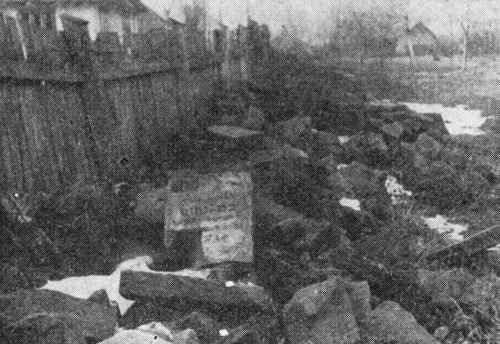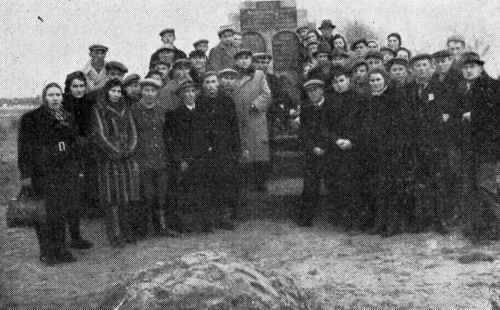 |
were gathered after liberation by the town's survivors
After the Holocaust
After the Shoah
 |
unveiled a tombstone on the grave of the martyrs
|
|
[Columns 709-710]
were gathered after liberation by the town's survivors |
After the Holocaust |
|
After the Shoah |
unveiled a tombstone on the grave of the martyrs |
Translator's Footnote:
[Columns 711-712]
Translated by Elena Hoffenberg
On Thursday, November 30, the Nazi authorities in Chelm ordered all Jewish men, aged fifteen to sixty, to report the next day, December 1, at 8:30 a.m., in the Market Square. About 2,000 Jews appeared. They were attacked by the Nazi police auxiliary, the “Black Guard”, and by a small company of soldiers armed with machine guns. The Gestapo officer then gave a short speech to the Jews, informing them that since the Jews were guilty of the war, and they were Germany's enemies, the Jews were condemned by the Nazi authorities to lose their civil rights and to be expelled from the city.
At 12:30, the Jews, surrounded by members of the Nazi assault companies and soldiers in trucks or riding motorcycles, were ordered to leave the city and take the road leading from Hrubieszow.
A few miles from the city, near a military hospital in a grove, the convoy was ordered to stand, and the Nazis told them that since one of the men had tried to escape, twenty of them would be executed, and for every such attempt fifty would be executed. Twenty Jews among them were randomly selected and led away.
On Saturday night, the Nazi authorities in Hrubieszow issued an order to the Jews of the city, similar to the order given to the Jews of Chelm. At nine–thirty, the Jews of Chelm joined them.
It is estimated that a total of 1,100 Jews from Chelm and 850 Jews from Hrubieszow were present in the same convoy. Before they were ordered to leave, they were warned that if any of them returned home, he would be considered a spy and executed. Through the fields, forests and swamps, the Jews ran from Hrubieszow to Minyani, Tsikhovoja and Dolevichov. Every five minutes the Nazis ordered those who had fallen behind and could not continue on their way to retire. These were shot and killed on the spot, and their bodies remained lying in the fields.
When they arrived in Dolevichov, the surviving people were divided into two groups: one of about 500 people and the second 400.
From Dolevichov the large convoy was ordered to go in the direction of the border city, Sokal, and the small convoy of 400 – to the border city of Belz. The last convoy was more fortunate than the first, as only a few of its people were killed by the Nazis: on the other hand, about 250 of the large convoy were shot and killed before reaching the bridge over the Bug River, which separates the Nazi part from the Soviet part of Sokal. In all, more than 1,300 Jews from Chelm and Hrubieszow were slaughtered by the Nazis during the four days of marching, under an oppressive baton, toward the Soviet border.
During the four days of the walk, the Jews were given only one loaf of bread per day, which was to be divided between thirty people. On average, one Jew was shot and killed by the Nazis every 10 minutes of walking. From time to time the Nazis could be heard exchanging remarks about the number of Jews they murdered.
– In fact, my hand “arranged” seventy–six.
The other responded:
– And I only killed sixty–three.
Among the murdered Jews were fathers and sons from one family. Yitzhak Levinsan, the 55–year–old manager of the Jewish bank in Hrubieszow, had exhausted his strength completely and could no longer continue on his way, 15 km away from Hrubieszow. When the Nazis ordered him to lie down, as a sign that he was about to be executed, Mendel, his 22–year–old son, offered to die in his place, but his offer was rejected.
So Mendel said:
–If so, I will lay down along with my father.
The members of the contingent answered this simply:
–Is that how you volunteer to die? Very Good!
And the father and son were both shot and killed.
The German news agency, which announced this massacre in mid–December, put it this way:
“The attempted revolt of the Jews of Chelm and the Hrubieszow – ruthlessly suppressed”
From “The War Front of the Jewish People” by Ze'ev Jabotinsky.
|
|
| Identification card of Wolf Lerer, published by the Hitlerist state authorities |
|
|
| The identification card of Pesiye Kaufman, published by the Hitlerist state authorities |
In the Borowkowitz Sawmill
In May 1941, a pioneer kibbuz of “Dror” was established in the sawmill near Hrubieszow (in the village of Warbkovits), with about 40 members. Its secretary was Moshe Rubanitznik. Some of them, including Shaul Dubovno, came here from the pioneer center at 34 Dzelena Street in Warsaw.
In August 1942, during the deportation to extermination, another 30 members were sent there and ordered to start, together with their predecessors, partisan activity in the area. Shortly after, a third group of 18 fighters was sent (the three groups numbered about 60 people), including C. Gershoni, Pesia Fromanovits, Y. Katz, Y. Nozitsa, Ruth Sheklar, Dina Levin, and more – and it failed during a check of documents on the way to Hrubieszow . Only one young member, Moniak Shtangal, managed to return to Warsaw. The rest of them were murdered on the spot, except for Israel Zaltzer, who was led from there by the Gestapo to Pawiak in Warsaw and murdered there. The failure of this group also lead to the destruction of all of the members who were gathered around the sawmill near Hrubieszow.
by Mordecai Hurwitz (Givatayim, Israel)
Translated by Elena Hoffenberg
|
|
| Mordecai Hurwitz |
At a press conference which took place in Jerusalem on October 29, 1947, with the poet Leib Yaffe as chair, in honor of the poets Yehuda Burla, Mordecai Hurwitz, and Y. Zaltsberger, who had returned from missions in North and South America and in Poland, the fellow–countryman M. Hurwitz gave his impressions from his visit to Poland in the year 1946, as well as his experiences during his visit to Hrubieszow. Among other things, M. Hurwitz said the following:
A feeling of being an orphan lays upon each one of us and one cannot be freed from this feeling. Each plant, each street, each stone calls and screams and does not let one forget.
I traveled through many towns in Poland. Small towns, whose names are not even remembered. Everything remained. There are towns, where even the synagogues remained whole, but they have been changed into a workshop or into a church. I went to Zamość. Everything remained whole, but I did not meet a single Jew there.
From there I went to Hrubieszow. The study houses, the prayer houses of the Triskers, the Shateners and others were destroyed or converted into workshops for carpentry and blacksmithing.
The great synagogue is serving as a place for trash. I was walking on the sidewalk–on the path to the former “Tel Chai” school–and the sidewalk was paved with tombstones for Jews, [with] Jewish letters, names of relatives, of mother and father. One wants to run away from this reality but the fate of the facts drives one further.
Aside from the feeling of being an orphan, you are accompanied also by the feeling of being an invalid. The remaining Jews in Poland are as a matter of fact invalids.
I asked myself: what are the strengths that make it possible for the remaining Jews to survive and to begin a new life from the beginning?
It is but belief, hope, and partnership with Israel. Each message from Israel inspires enthusiasm. Each piece of news about ships of illegal immigrants, or the establishment of a new settlement, is a great joy for the remaining survivors.
Zalman Shazar and Hrubieszow
During my mission to Poland, I met with Zalman Shazar Rubashov, the chair of the Jewish Agency in Jerusalem.
“Dear Rubashov, do you know my birthplace, Hrubieszow?” I asked him.
He answered, “what a question, my grandfather himself was born in Hrubieszow and my family name Rubashov comes from there, that is: from Hrubieszow.”
History Repeats Itself!
|
|
|||
and the windows torn out |
R' Shlomo Fayvish Bar Natan Faytl in his book “Tit Ha'yavan” tells: “The Cossacks came to the holy community of Rubashov [Hrubieszow] and there they killed hundreds of heads of households and almost everyone was killed.” This was three hundred years ago in the times of the Khmelnytsky pogroms.
|
|
JewishGen, Inc. makes no representations regarding the accuracy of
the translation. The reader may wish to refer to the original material
for verification.
JewishGen is not responsible for inaccuracies or omissions in the original work and cannot rewrite or edit the text to correct inaccuracies and/or omissions.
Our mission is to produce a translation of the original work and we cannot verify the accuracy of statements or alter facts cited.
 Hrubieszów, Poland
Hrubieszów, Poland
 Yizkor Book Project
Yizkor Book Project
 JewishGen Home Page
JewishGen Home Page
Copyright © 1999-2025 by JewishGen, Inc.
Updated 22 Sep 2022 by LA